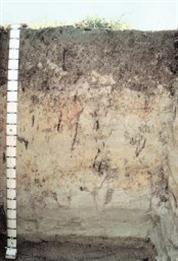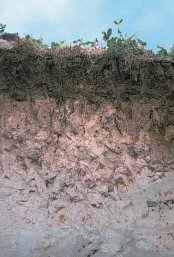Soil Formation:
Topics:
Series Definition:
Similar Soils:
Dominant Soil Types:
Chemical and Physical Features:
Variant:
Distribution of Soil Map Units:
Coarse alluvium deposited by the ancient Waikato river system was bounded by numerous stream channels which were continually altering in direction and water velocity. When a particular section of channel was abandoned by fast-flowing water, the slow currents or stagnant water allowed silts and clays carried in suspension to settle on the sandy stream bed. Deposition of fine particles also occurred in other lowlying areas which were flooded with sediment-laden water. This explains both why their upper subsoils are of silty and clayey materials on a lower sandy subsoil, and the soils' position in lower areas of the plain. On a soil map the stream-like distribution of Te Kowhai soils can be seen.
Any subsequent increase in stream current could result in a layer of sand on top of the deposited silts and clays. In this way the layered profiles of the Te Kowhai soils were formed.
The high proportion of fine material, in particular silt, which disperses to block pores, has resulted in compact subsoil layers with slow permeability. These layers which restrict downward water movement, together with the soils' low position in the landscape, combine to produce poorly drained conditions. Under these conditions a lack of oxygen causes iron (which gives soils their yellowish colour) to be reduced and removed from the soil. This results in white or light grey subsoil colours. Some blotches or mottles of yellowish colour may occur along cracks and pores where oxygen is still able to enter the subsoil. In places, humus and peaty material may accumulate in the topsoil and lightly stain the upper subsoil a yellowish brown colour.
Another result of poorly drained conditions is the formation of the clay mineral called halloysite. Halloysite causes the soil to be sticky when wet and to shrink and crack when dry. With time, clay, silt and humus have washed down into the soil to coat some of the soil aggregates.
Soils of the Te Kowhai series are characterised in the field as follows:
1. They are mineral soils which may have humic or peaty topsoils less than 40 cm thick.
2. The subsoil is light grey, often with yellowish brown mottles.
3. Those soils with peaty or humic tops may have a light yellowish brown upper subsoil, often with yellowish brown mottles.
4. The upper subsoil is silt loam or finer in texture.
5. The soil material is slightly sticky to sticky when wet.
6. Subsoil structures are commonly moderately developed and coarse in size.
7. The soil is uncemented but some layers may be very firm.
8. Profiles are poorly drained with a layer of slow permeability in some part.
The Te Kowhai series is composed of several soil types which have been separated according to topsoil texture and humus staining of the upper subsoil. Te Kowhai silt loam (Plate 5) is the most common soil type. The main soil types are:
Te Kowhai silt loam
Te Kowhai clay loam
Te Kowhai humic silt loam
Te Kowhai humic clay loam
Te Kowhai peaty silt loam
Te Kowhai silt loam with brown subsoil
Te Kowhai peaty silt loam with brown subsoil
Te Kowhai humic silt loam with brown subsoil
Te Kowhai humic clay loam with brown subsoil
Soils of the Te Kowhai series commonly have a near neutral topsoil grading to a strongly acid or slightly acid lower subsoil. Phosphate retention is low. Humic and peaty Te Kowhai soils with brown subsoils are strongly acid throughout and have medium to high phosphate retention in the topsoil and upper subsoil. The soils have medium reserves of many nutrient elements and a medium capacity for supplying them for plant use.
The soils are layered and texture may vary considerably with depth. Soil density also varies, from medium to high, and permeability is slow owing to firm compact layers. Poor drainage restricts the majority of roots to the topsoil. In summer they can extend down cracks into the subsoil as the water table drops. Readily available water storage in the root zone is low but the high water table can provide an additional water source. The soils have limited workability and are slightly sticky when wet.
Poor drainage resulting from compact slowly permeable subsoil layers is the main soil limitation. There is also restricted subsoil aeration. Drainage is required but in many areas this would need to be accompanied by ripping or moling to break the compact subsoil. Summer irrigation would also benefit most crops. Even with drainage and irrigation it is unlikely that Te Kowhai soils will be improved sufficiently to allow a wide range of crops to be grown. The soils are, however, well suited to pasture production and are of high potential value for food production.
Land mapped as soils of the Te Kowhai series covers 219 ha or 33% of the total area. The soils commonly occur on the lower-lying areas of land and have formed mainly from silty over sandy and clayey over sandy alluvial material. Subsoil layering of these materials is common.
Rotokauri soils are similar to Te Kowhai soils; however, they are not as layered as Te Kowhai soils, and they are also wholly clay or silty clay to at least 1m depth. Rotokauri soils commonly occur on low rolling hills or on the flat land at the base of the hills.
Some Te Rapa soils are similar to Te Kowhai soils with humic or peaty topsoils and brown subsoils. However, these Te Kowhai soils have a light yellowish brown subsoil while that of the Te Rapa soils is yellowish brown.
Te Kowhai soil types:
Soils of the Te Kowhai series are poorly drained soils with slow permeabilities and a shallow rooting depth. Topsoils are dark greyish brown silt loam or clay loam, and they occur on a light grey silt loam or silty clay loam upper subsoil which is slowly permeable and which has many yellowish brown mottles. The lower subsoil is light grey sand.
Topsoils may also be humic or peaty, and commonly associated with these is a humus-stained light yellowish brown upper subsoil. Readily available water storage in the root zone is very low. This improves to low in summer as the water table drops and roots are able to penetrate deeper. Although water storage in the root zone is low, plants are able to obtain extra water from the high water table. This extra water can be particularly important in the dry summer months. The water table commonly results from compact, slowly permeable subsoil layers restricting downward water movement. However, in winter these slowly permeable layers prevent adequate drainage and may result in very wet soil conditions.
The main soil limitation is poor drainage resulting from water trapped on compact slowly permeable subsoil layers. In some cases the excess water is also the result of a high regional water table. The soils are, however, of high potential value for food production and are well suited to dairy and cattle production.
A brief description of a typical Te Kowhai soil is:
Topsoil: 20 cm of dark greyish brown or very dark greyish brown silt loam or clay loam which may be humic or peaty; moderately weak soil strength in situ; slightly sticky; moderately developed fine nut structure breaking to very fine nut.
Upper subsoil: 50 cm of light grey silt loam or silty clay loam with many
medium prominent brownish yellow mottles; moderately weak to moderately firm soil strength in situ; moderately developed coarse prismatic and block structure.
Lower subsoil: Light grey massive single-grained sand with many medium yellowish brown mottles.
The peat material is completely decomposed. Subsoil materials vary in composition and thickness. Multiple layers of different textures are common, some only a few centimetres thick. Usually the upper subsoil is predominantly silt loam or silty clay loam. The lower subsoil is commonly sand. In the middle subsoil there is commonly a silty or clayey layer which is firmer and has coarser structure than those above. This layer has slow permeability and restricts drainage.
Soil structure tends to be moderately developed, grading to weakly developed with depth. Coarse structural aggregates in the upper subsoil are commonly coated with a mixture of brown humus material, silt and clay. Concretions of iron and manganese also occur in Te Kowhai soils but are uncommon.









